In an era where thematic depth and engaging gameplay have become paramount in the gaming industry, the anticipation surrounding the upcoming title “Guns Undarkness” stands out distinctly. Developed by Shoji Meguro, famed for his work on the Persona series and Shin Megami Tensei, this turn-based RPG promises visually striking designs and an immersive soundscape with the involvement of celebrated illustrator Ilya Kuvshinov and music producer Lotus Juice. What remains to be critically examined, however, is how these elements coalesce into a cohesive gaming experience, particularly in an industry that has blurred the lines between storytelling and gameplay.
Set in the year 2045, “Guns Undarkness” narrates the tumultuous aftermath of a nuclear war that has ravaged society, resulting in starkly divided social classes—the wealthy and the impoverished. The accusation that it mirrors real-world socio-economic disparities invites scrutiny; invoking concepts like the “Great Reset” inevitably places the game within a politically charged framework. The decision to explore themes of technological advancement juxtaposed against a backdrop of societal collapse demonstrates a nuanced understanding of contemporary issues. However, this approach inherits risks, particularly with the delicate handling of themes that have sparked various conspiracy theories in real life.
The narrative follows a rookie soldier tasked with uncovering deeper truths about love and humanity’s capacity for transformation amidst chaos. While the premise holds potential for a rich narrative exploration, it raises the question of whether the portrayal of these themes will be sophisticated or if it might fall prey to oversimplification conducive to political commentary. Hideo Kojima, a notable influence on the game, is renowned for his ability to weave complex narratives that engage audiences without trivializing important topics. Whether Meguro can achieve similar depth without veering into melodrama remains to be seen.
In terms of gameplay, “Guns Undarkness” incorporates a blend of traditional turn-based combat with tactical exploration elements, resembling complex systems found in titles like Rainbow Six. Players control a squad of four characters who embark on missions staged within the wreckage of a global catastrophe. Combat engages the player not only through turn-based mechanics but through a more strategic layer of positioning and environment utilization. This duality—wherein players must consider both offensive capabilities and positional tactics—suggests a deeper engagement than merely selecting attacks from a menu.
The inclusion of a reputation system reminiscent of Persona adds to the complexity. It fosters interpersonal dynamics among squad members that can significantly influence combat outcomes as characters develop bonds through cooperative fighting. This could reflect a wider trend within RPGs to focus on relationships as a core gameplay mechanic, creating a more personalized experience. Yet, the challenge lies in balancing these relationships with the overarching narrative; the game must ensure that character development feels rewarding without overshadowing the central plot.
What makes “Guns Undarkness” visually promising is the synergy between Kuvshinov’s artistic vision and the immersive audio crafted by Lotus Juice. The potential for this collaboration to deliver a uniquely stylized experience cannot be underestimated. A well-crafted aesthetic can enhance thematic depth, drawing players into the emotional landscape of the game while underscoring the gravity of its narrative. If executed well, it could create memorable visuals that resonate with players long after they’ve stepped away from the game.
However, as with the game’s themes and mechanics, it’s vital to ascertain that the visuals and audio align cohesively with gameplay. A visually striking game that fails to deliver engagement through its mechanics can lead to player disappointment, falling short of the high expectations set by its prominent contributors. Therefore, maintaining consistency across artistic and gameplay elements will be key to “Guns Undarkness” gaining critical and commercial success.
As “Guns Undarkness” approaches its release, the gaming community watches with hopeful yet wary anticipation. The combination of innovative gameplay mechanics, timely thematic exploration, and a visually captivating design creates an exciting prospect. However, with great potential comes greater scrutiny, especially when tapping into sensitive themes such as societal division and technological overreach.
The true test for “Guns Undarkness” will be its ability to authentically integrate these elements into a compelling and thought-provoking gaming experience. If it can strike the delicate balance between gameplay and narrative while delivering a poignant social commentary, it may carve out its own space in a complex gaming landscape. As it stands, the groundwork is laid for a captivating title; the execution, however, will ultimately define its legacy.

